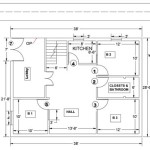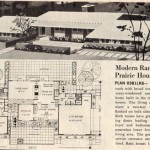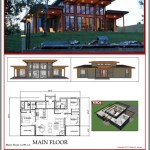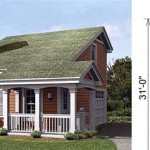How To Draw a House Plan Without AutoCAD
Creating a house plan is a fundamental step in any construction or renovation project. While Computer-Aided Design (CAD) software like AutoCAD offers powerful tools for this purpose, it isn't always accessible or necessary, particularly for initial design phases or for those without technical expertise. Producing a house plan without AutoCAD is achievable through several methods, ranging from simple hand-drawing techniques to the utilization of user-friendly alternative software.
The purpose of a house plan is to provide a scaled representation of a building, illustrating room layouts, dimensions, and key structural elements. It serves as a visual communication tool between the designer, the client, and the construction team. A well-executed house plan ensures that all parties involved understand the design intent, facilitating accurate construction and minimizing potential errors.
This article outlines the steps and techniques involved in drafting a house plan without the need for AutoCAD, focusing on alternative tools and best practices. By understanding these methods, individuals can effectively visualize and communicate their design ideas, even without specialized software.
Understanding the Fundamentals of House Plans
Before commencing the drawing process, a clear understanding of the components of a house plan is essential. A typical house plan consists of several key elements, including:
*Floor Plan:
This is the most common view, depicting the layout of rooms, walls, doors, windows, and other architectural features as seen from above. It typically includes dimensions and annotations providing specific information about each space. *Elevations:
These are orthographic projections showing the exterior views of the house from each side (front, rear, left, and right). Elevations illustrate the vertical appearance of the building and show details such as roof pitch, window heights, and exterior finishes. *Sections:
These views cut through the building vertically, revealing the interior structure and relationships between different levels. Sections often show details such as wall construction, floor heights, and ceiling types. *Site Plan:
This shows the house in relation to the property boundaries, neighboring buildings, roads, and other site features. It typically includes information about landscaping, utilities, and access points.Accuracy in these representation is paramount. Regardless of the mode of drawing, accurate measurements and adherence to architectural conventions are critical for ensuring the feasibility and buildability of the design. Familiarizing oneself with standard architectural symbols and notations ensures effective communication between all parties involved.
Furthermore, before attempting to draw the plan, it is important to determine the scale to be used. The scale determines the relationship between the dimensions on the drawing and the actual dimensions of the building. Common scales for house plans include 1/4 inch = 1 foot or 1/8 inch = 1 foot. The selection of scale will affect the level of detail that can be included on the plan.
Methods for Drawing House Plans Manually
Hand-drawing techniques remain a viable option for creating house plans, especially during the initial conceptual stages. This method allows for intuitive design exploration and facilitates a tactile connection with the design. The following steps outline the process of creating a house plan by hand:
*Gather Necessary Materials:
Essential materials include graph paper, pencils (varying hardness), erasers, a ruler, a scale ruler if available, a protractor, and a compass. Graph paper provides a pre-defined grid, which simplifies the process of drawing to scale. *Sketch the Outline:
Begin by sketching the exterior walls of the house, ensuring that the dimensions are accurate according to the chosen scale. Consider the overall shape of the building and the placement of exterior features such as doors and windows. *Divide the Interior Space:
Divide the interior space into rooms, considering the desired room sizes and relationships. Draw the interior walls, ensuring that they are aligned with the exterior walls and that the dimensions are consistent. *Add Architectural Details:
Incorporate architectural details such as doors, windows, stairs, and fixtures. Use standard architectural symbols to represent these elements accurately. Indicate the swing direction of doors and the location of windows. *Dimension and Annotate:
Add dimensions to the plan, indicating the lengths of walls, the sizes of rooms, and the locations of doors and windows. Annotate the plan with text to identify each room and to provide additional information about specific features. *Review and Refine:
Review the plan carefully, checking for errors and inconsistencies. Make any necessary revisions to ensure that the plan accurately reflects the design intent.Hand-drawing requires meticulous attention to detail and a thorough understanding of architectural principles. While it may be more time-consuming than using CAD software, it offers a direct and intuitive way to translate design ideas into a tangible form.
When drawing manually, it is helpful to use a light pencil for initial sketches and then darken the lines that are to be kept. This allows for easy corrections and revisions. It is also important to use a consistent line weight for different elements of the plan, such as walls, doors, and windows. This helps to create a clear and readable drawing.
Using Alternative Software for House Plan Creation
Several user-friendly software options provide alternatives to AutoCAD for creating house plans. These programs offer a range of features, including drag-and-drop functionality, pre-designed templates, and 3D visualization capabilities, making them accessible to users with varying levels of technical expertise. Some popular options include:
*SketchUp:
While not specifically designed for house plans, SketchUp is a versatile 3D modeling program that can be used to create detailed floor plans and elevations. Its intuitive interface and extensive library of pre-built components make it a popular choice for architects and designers. The free version of SketchUp is sufficient for many basic house plan drawing tasks. *Planner 5D:
This online tool offers a user-friendly interface and a wide range of pre-designed elements, making it easy to create floor plans and 3D visualizations. Planner 5D allows users to customize the layout, furniture, and finishes of their designs. *SmartDraw:
A diagramming tool that includes templates specifically designed for creating house plans. SmartDraw offers a range of features, including automatic dimensioning, symbol libraries, and collaboration tools. *Floorplanner:
As the name suggests, this web based tool provides an easy-to-use interface for creating floor plans. It allows for the creation of 2D and 3D models, and includes a library of furniture and other architectural elements.When using alternative software, it is important to choose a program that meets the specific needs of the project. Some factors to consider include the level of detail required, the desired rendering style, and the available budget. Many of these programs offer free trials or limited free versions, allowing users to experiment with different options before committing to a purchase.
Regardless of the software chosen, it is important to understand the program's features and limitations. Take the time to read the documentation and to experiment with the different tools. Many software programs offer tutorials and online support to help users get started.
Furthermore, it is recommended to save the work frequently to avoid losing progress in case of a software crash. Also, exporting the completed plan in a commonly used file format, such as PDF or DWG (if the software allows), ensures that it can be easily shared and viewed on different devices.
Key Considerations for Accuracy and Communication
Regardless of the method used to create the house plan, accuracy and clear communication are paramount. The following considerations will contribute to a successful outcome:
*Maintain Consistent Scale:
Ensure that all dimensions and measurements are consistent with the chosen scale. Using a scale ruler can help to maintain accuracy. Double-check all measurements before finalizing the plan. *Use Standard Architectural Symbols:
Use standard architectural symbols to represent doors, windows, fixtures, and other elements. This ensures that the plan is easily understood by architects, contractors, and other professionals. *Provide Clear Annotations:
Annotate the plan with clear and concise text to identify each room and to provide additional information about specific features. Use consistent terminology and avoid jargon. *Review and Validate:
Review the plan carefully with all stakeholders to identify any errors or inconsistencies. Validate the plan by comparing it to the actual site conditions and building codes. *Consider Building Codes and Regulations:
Adherence to local building codes and regulations is crucial. Consult with local authorities. These codes dictate the minimum requirements for various aspects of the building, such as fire safety, accessibility, and structural integrity. Checking building codes is a crutial step that must be done before proceeding with the construction plans.By following these considerations, individuals can create house plans that are accurate, informative, and compliant with relevant standards. These elements are critical for facilitating a smooth and successful construction or renovation project.
When communicating the house plan to others, it may be helpful to provide a key or legend that explains the symbols and annotations used. This can help to ensure that everyone understands the plan correctly. It is also helpful to provide multiple views of the house, such as floor plans, elevations, and sections. This provides a more complete picture of the design.

Floor Plans Learn How To Design And Plan

Floor Plan Creator And Designer Free Easy App

Making A Simple Floor Plan In Autocad Part 1 Of 3

Floor Plan Create 2d 3d Plans Autodesk

Basic Floor Plan Drafting In Autocad 7 Steps Instructables

How To Draw Floor Plans In Autocad Edrawmax

Floor Plan For Practice Buildings And Structures Housing Plans Architectural House Simple

Draw House Plan Without Installation Autocad Web App Series Lecture 2

Is Autocad The Best Floor Plan For Estate Agents Elements Property

How To Draw Floor Plans In Autocad Edrawmax
Related Posts








